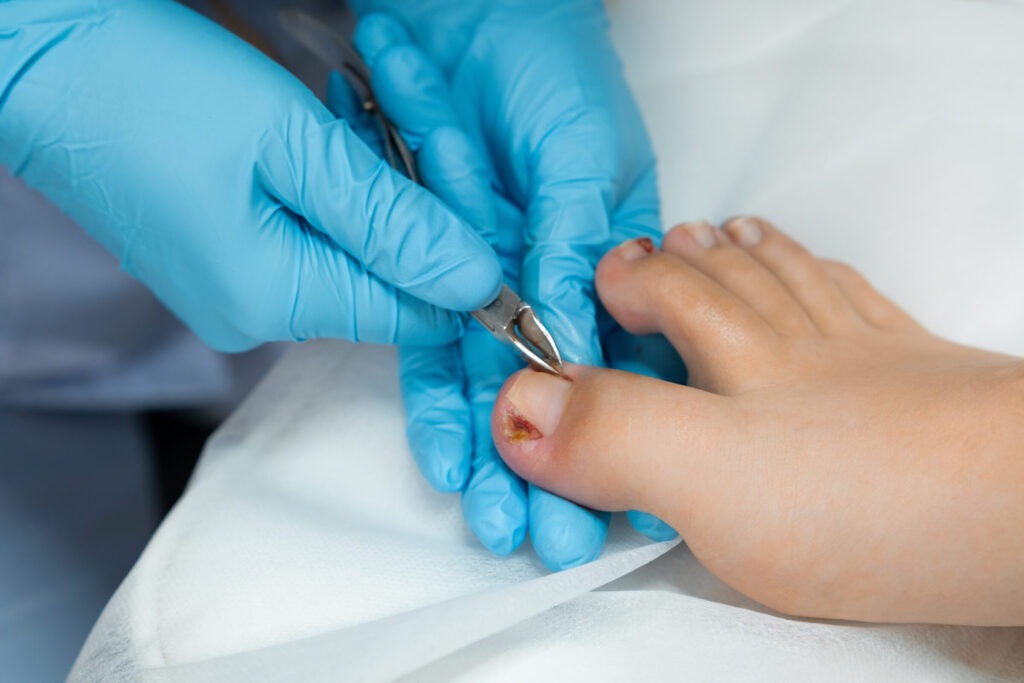An ingrown toenail may seem like a minor issue—until it starts to hurt with every step you take. What starts as a little redness or swelling can quickly become painful, infected, and disruptive to your daily life. The good news? Ingrown toenails are treatable and often preventable with the right care.
What is an Ingrown Toenail?
An ingrown toenail occurs when the edge of the toenail, usually the big toe, grows into the surrounding skin. This causes irritation, inflammation, pain, and in some cases, infection.
Common symptoms include:
- Redness and swelling around the toenail
- Tenderness or pain along one or both sides of the nail
- Pus or drainage if infection is present
- Difficulty wearing shoes or walking comfortably
What Causes Ingrown Toenails?
Several everyday habits can lead to ingrown toenails:
- Improper nail trimming: Cutting toenails too short or rounding the corners can encourage the nail to grow into the skin.
- Tight footwear: Shoes that squeeze your toes or put pressure on the toenail can contribute to the problem.
- Injury or trauma: Stubbing your toe or repetitive pressure from sports can cause nail damage.
- Genetics: Some people inherit naturally curved nails or nail beds more prone to becoming ingrown.
How to Treat a Mild Ingrown Toenail at Home
If caught early and there’s no sign of infection, you can try these steps:
- Soak Your Foot:
Soak the affected foot in warm, salty water 2–3 times a day. This softens the skin and reduces inflammation. - Apply an Antiseptic:
Clean the area and apply an over-the-counter antibiotic cream to prevent infection. - Wear Proper Footwear:
Avoid tight or narrow shoes while the toe heals. Open-toed sandals can help reduce pressure. - Don’t Cut It Further:
Avoid trying to “dig out” the ingrown nail yourself as this can make it worse or lead to infection.
When to See a Podiatrist
Home treatment doesn’t always do the trick. You should schedule an appointment with a podiatrist if:
- The ingrown nail is severely painful, swollen, or infected
- You notice pus, increasing redness, or streaking
- You have diabetes, poor circulation, or a compromised immune system
- The problem keeps coming back
Professional Treatment Options
At South Dublin Podiatry, we offer several effective options depending on the severity:
- Nail Edge Removal (Partial Nail Avulsion): Under local anesthetic, a portion of the nail is removed to relieve pressure and allow healing.
- Antibiotics: For infected ingrown nails, we’ll prescribe a topical or oral antibiotic.
Preventing Ingrown Toenails
You can reduce your risk with a few simple habits:
- Trim nails straight across, not curved
- Avoid cutting nails too short
- Wear properly fitted shoes with room for your toes
- Protect your feet during sports or work
- Check your feet regularly, especially if you have diabetes or other risk factors
Take the First Step Toward Pain-Free Feet
Ingrown toenails are common, but they don’t have to be a chronic problem. If you’re struggling with pain, swelling, or recurring infections, we’re here to help.
Don’t let an ingrown toenail slow you down, Book a chiropody appointment with one of our skilled Podiatrists now, or for recurring ingrown toenails book a nail surgery consultation!
If you are concerned about your feet, call us on 01-9012009 or fill out the form below.

